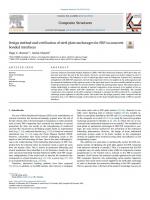Design method and verification of steel plate anchorages for FRP-to-concrete bonded interfaces
- Citation:
- Design method and verification of steel plate anchorages for FRP-to-concrete bonded interfaces, Biscaia, Hugo C., and Chastre Carlos , Composite Structures, 5/15/, Volume 192, p.52-66, (2018) copy at https://docentes.fct.unl.pt/cmcr/publications/design-method-and-verification-steel-plate-anchorages-frp-concrete-bonded-interfac

Abstract:
Concrete structures Externally Bonded Reinforced (EBR) with Fibre Reinforced Polymers (FRP) have been studied and used since the end of the last century. However, several issues need to be better studied in order to improve performance. The influence of size of anchorage plates used on Reinforced Concrete (RC) structures strengthened with EBR FRP composites, the external compressive stress to be applied on the anchorage plate and the numerical simulation of this region are some of the topics that need to be more carefully studied in order to clarify the performance of the FRP-to-concrete interface within the anchorage plate region. This study proposes a design methodology to estimate the amount of external compressive stress necessary to be applied on the anchorage plate of EBR systems with FRP composites, in order to avoid premature debonding. The external compressive stress imposed on the FRP composite is intended to simulate the effect produced by a mechanical anchorage system tightened to the EBR system. The results from the design proposal, when compared with the numerical ones, were efficient enough on the prediction of the bond strength improvement of FRP-to-concrete interfaces.
Notes:
n/a
